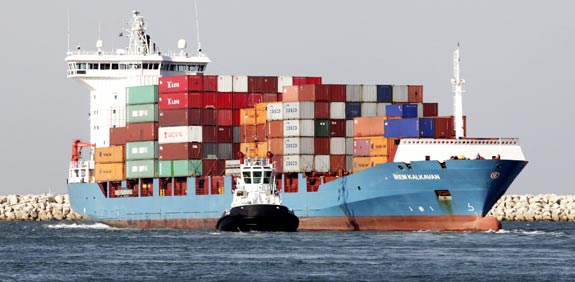Israel spends too much on defence warns IMF
Two articles from Ynet plus table of military spending as proportion of GDP by country.

Container ship “Irem Kalkavan” is guided by a tugboat as it arrives at the Port of Haifa in Israel. Israel’s imports are rising and its exports falling. Photo by Ariel Jerozolimski/Bloomberg
IMF calls for NIS 5 billion cut in Israel’s budget deficit
New report claims increased defence spending make government’s 2016 deficit goals impossible; tax cuts may exacerbate problem.
By Amnon Atad, Calcalist
September 17, 2015
Israel’s deficit goal set by the government for the coming year (2% of GDP), cannot be reached due to increased defence spending, according to the findings of an International Monetary Fund (IMF) report released Wednesday.
The report was delivered into the hands of Finance Minister Moshe Kahlon and Governor of the Central Bank of Israel Karnit Flug and recommended that the government effectively cut spending in 2016’s budget by at least NIS 5 billion.
Such a cut would reduce the deficit, or the difference between expenditure and income, in 2016’s budget by at least 0.5% from the 2.9% that has already been approved.
The recommendation from the IMF contradicts a recent decision from Prime Minister Benjamin Netanyahu and Finance Minister Kahlon to reduce the VAT tax as well as taxes on businesses and the sale of alcohol.
The tax cuts, which were approved based on left-over funds from the 2015 budget, will inevitably reduce next year’s tax revenue and therefore increase the 2016’s deficit.
The IMF recommendation is reinforced even further by its estimate for growth in the Israeli economy next year at 3.3% – a forecast also predicted by the Treasury.
If the economy does grow in 2016 as planned for in the budget, but the 1% VAT tax cuts and 1.5% reductions for business continue as planned, the government will most likely struggle to meet the deficit goal approved in budget negotiations.
The IMF report also addressed an economic issue felt sharply by most Israelis – the high cost of housing throughout the country. According to the report, supply is the biggest issue in the market that’s driving prices skyward.
Index Mundi table
Rank Country Military expenditures – percent of GDP, 2014
1 South Sudan 10.32
2 Oman 8.61
3 Saudi Arabia 7.98
4 Israel 5.69
5 United Arab Emirates 5.5
6 Azerbaijan 5.2
7 Afghanistan 4.74
8 Jordan 4.65
9 Algeria 4.48
10 Russia 4.47
11 United States 4.35
12 Lebanon 4.04
13 Yemen 4.02
14 Armenia 3.92
15 Kyrgyzstan 3.74
16 Angola 3.63
17 Morocco 3.55
18 Singapore 3.52
19 Colombia 3.28
20 Swaziland 3.17
Israel Exports Institute Chairperson Ramzi Gabai tells Ynet about Israel’s rising trade deficit and possible solutions.
By Alexandra Lukash, Ynet news
September 16, 2015
Since the start of 2015, Israel has seen its trade deficit grow to NIS 22.6 billion.
The Central Bureau of Statistics (CBoS) reported a protracted downturn for exports in the mixed high-technology (-14.4%), mixed traditional technology (-15.4%), and traditional technology (-4.6%) industries, with a corresponding rise in most import components.
In a special interview conducted with Exports Institute Chairperson Ramzi Gabai in the Ynet studio ahead of Rosh Hashanah, he noted that the slowdown in exports didn’t start in 2015.
“You need to remember that between 1980 and 2010 Israeli exports doubled every decade, but they haven’t been going forward for the past 5 years,” said Gabai. “We aren’t rising in exporting even though the country is growing, and this slowdown is happening for a number of reasons, including the status of the Shekel, the industrial development, and other components. All in all, were in a bad period and want to go on a new path.”
That’s why Shraga Brosh, President of the Manufacturers’ Association of Israel, President Gabai himself, and Ohad Cohen, the Foreign Trade Administration Director have recently presented Minister of the Economy Aryeh Deri with an “Israel exports” document, a roadmap for Israeli exporting, featuring suggestions for jumpstarting Israel’s exports and markets in general. The document stated a goal of raising exports to about $135 billion by 2020.
“The Economy Ministry understood and accepted the document,” said Gabai, noting that the people who wrote the document are the exporters themselves. “In a series of roundtable meetings we had with hundreds or exporters, they were asked what needed to be done, and they’re the ones who presented us with all of the problems and the solutions and that’s the document’s principal interest.
“That’s what we came to the Economy Minister with, and there’s willingness on his side, on the Prime Minister Netanyahu’s side, and Finance Minister Kahlon’s side,” Gabai said.
He explained that all three understand that without the Israeli exports there won’t be any growth. “We’re waiting to see how it goes, but I can say that I do see a light at the end of the tunnel. The government is willing to help market the products and open blockages that make industrialists’ work difficult,” he said.
Gabai clarifies that the export institute’s top priority is to help small exporters rather than big ones, since a significant portion of Israeli exports belongs to just ten large companies. “Most of the work done by the export institute is with small-to-medium sized exporters. These are the ones who need and get help. Teva and Intel know the job and can export on their own,” he said.
When asked about new markets, Gabai said, “We certainly have a place for new markets that will be here in 10-20 years. There’s no doubt that it’s the East, China and India, South Korea, Vietnam, and South America. We certainly invest great resources in those markets. Even so, we aren’t neglecting what we have today, because without Europe and America it would be very hard to succeed.”
See also
Israel’s defense budget up 9%, Globes, June 2015
Israeli exports down 6% in H1 2015, Globes, August 2015
IMF: Israel must curb defense spending, Jpost, February 2012
